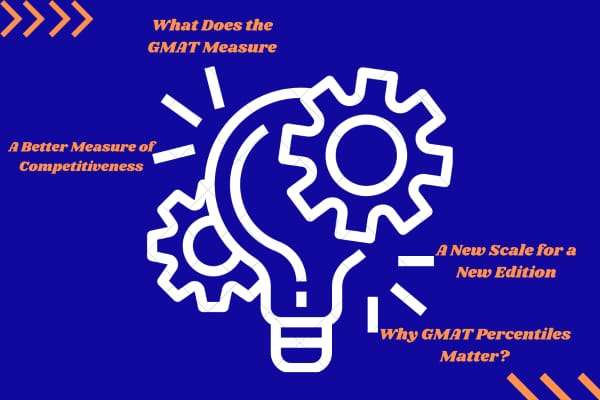
When preparing for the GMAT, understanding the scoring system is crucial to setting goals and interpreting your performance. With the introduction of the GMAT Exam (Focus Edition), the score scale has undergone significant changes, making it easier for test takers and schools to distinguish scores between editions. Here we’ll break down these changes and explain what they mean for you. GMAT percentiles interpretation is key to being able to map the scores between the old and the new Focus Edition
Total Score: A New Scale for a New Edition
GMAT Exam (Focus Edition): 205–805
GMAT Exam (10th Edition): 200–800
The Total Score scale for the GMAT Exam (Focus Edition) differs from the previous edition to reflect shifts in the global test-taking population. Over the years, as the GMAT has reached a more diverse and international audience, the score distribution has become uneven. The updated scale addresses this issue, enabling schools to better differentiate applicants based on their performance.
645 is the New 700
In the previous GMAT Exam (10th Edition), a score of 700 was a common benchmark for many applicants aiming for top business schools. However, with the new scoring system, a score of 645 on the GMAT Exam (Focus Edition) is equivalent to a 700 on the older test. While the numbers may seem lower at first glance, it’s important to remember that the new scale is not a reflection of decreased difficulty but rather a reconfiguration of scoring. Business schools are well aware of this adjustment and focus more on your percentile ranking than just the raw score.
GMAT Percentile Rankings: A Better Measure of Competitiveness
What Are Percentile Rankings?
Percentile rankings show how you performed compared to other test takers. For instance, a percentile ranking of 75% means you outperformed 75% of test takers, while 25% performed better than you.
Interpreting Percentile Rankings on the Focus Edition
Your Total Score on the GMAT Exam (Focus Edition) is equally weighted across the three sections:
- Quantitative Reasoning
- Verbal Reasoning
- Data Insights
Below is a sample of percentile rankings based on Total Scores for the GMAT Exam (Focus Edition):
| Total Score | Percentile Ranking |
|---|---|
| 805 | 100% |
| 755 | 100% |
| 705 | 98% |
| 655 | 91% |
| 605 | 72% |
| 555 | 49% |
| 505 | 28% |
| 455 | 15% |
| 405 | 7% |
| 355 | 3% |
| 305 | 1% |
| 255 | 0% |
| 205 | 0% |
Score Comparison: Why GMAT Percentiles Matter?
Because the score scale and distribution for the GMAT Exam (Focus Edition) differ significantly from the GMAT Exam (10th Edition), directly comparing Total Scores across editions is neither accurate nor meaningful. Instead, percentile rankings provide a more appropriate and standardised method of comparison.
If you need to understand how your performance on the GMAT Exam (Focus Edition) compares to the older edition, which maps Total Score distributions between the two exams by percentile. This approach ensures that you’re evaluating your competitiveness fairly and within the proper context.
What Does the GMAT Measure?
The GMAT evaluates higher-order reasoning and data literacy skills essential for success in a technologically advanced and data-driven world. The Total Score is composed of three equally weighted sections:
- Quantitative Reasoning: Measures numerical and problem-solving skills.
- Verbal Reasoning: Assesses reading comprehension and critical reasoning.
- Data Insights: Tests the ability to analyze and interpret data effectively.
The GMAT Exam (Focus Edition) continues to be a reliable tool for predicting the potential success of graduate business students, with its updated scoring system reflecting the evolving needs of a global test-taking population.
Key Takeaways
- The GMAT Exam (Focus Edition) introduces a new Total Score scale of 205–805, replacing the previous 200–800 range.
- A score of 645 on the new scale is equivalent to a 700 on the older GMAT Exam (10th Edition).
- Business schools prioritise GMAT percentiles rankings over raw scores when assessing applicants.
- Use comparison tables for meaningful comparisons between the two GMAT versions.
By understanding these changes, you can better position yourself for success in the competitive business school application process. Focus on your strengths, aim for a high GMAT percentiles ranking, and leverage the new scoring system to your advantage.
Here are some articles on how different students fared on the GMAT Exam!
- Improving Score from 500+ to 700+
- How hard is GMAT?
- Scoring 700+ on GMAT Focus Edition
